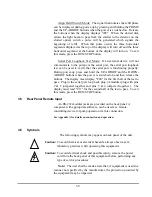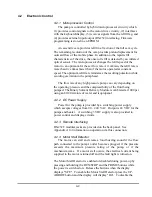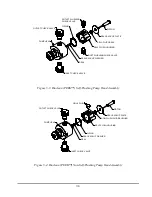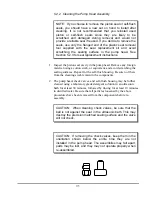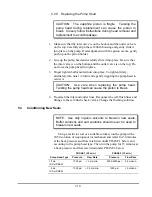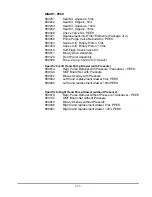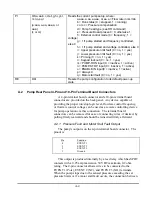
7-10
5.2.5 Replacing the Pump Head
CAUTION: The sapphire piston is fragile. Twisting the
pump head during replacement can cause the piston to
break. Closely follow instructions during head removal and
replacement to avoid breakage.
1. Make sure that the inlet valve is on the bottom and the outlet valve is
on the top. Carefully align the self-flush housing and gently slide it
into place on the pump. If misalignment with the piston occurs, gently
push up on the piston holder.
2. Line up the pump head and carefully slide it into place. Be sure that
the inlet valve is on the bottom and the outlet valve is on the top. Do
not force the pump head into place.
3. Finger tighten both knurled nuts into place. To tighten firmly,
alternately turn nuts 1/4 turn while gently wiggling the pump head to
center it.
CAUTION: Use care when replacing the pump head.
Twisting the pump head can cause the piston to break.
4. Re-attach the inlet and outlet lines. Reconnect the self-flush lines and
fittings to the self-flush check valves. Change the flushing solution.
5.3
Conditioning New Seals
NOTE: Use only organic solvents to break-in new seals.
Buffer solutions and salt solutions should never be used to
break-in new seals.
Using a restrictor coil or a suitable column, run the pump with a
50:50 solution of isopropanol (or methanol) and water for 30 minutes
at the back pressure and flow rate listed under PHASE 1 below and
according to the pump head type. Then run the pump for 15 minutes at
a back pressure and flow rate listed under PHASE 2 below.
PHASE 1 (30 min.)
PHASE 2 (15 min.)
Pump Head Type
Pressure
Flow Rate
Pressure
Flow Rate
10 mL
(SS or PEEK)
1000 psi
< 3 mL/min.
3000-4000 psi
3-4 mL/min.
5 mL
(SS or PEEK)
1000 psi
< 2.5 mL/min.
1500 psi
< 5 mL/min.
Summary of Contents for BINARY SOLVENT DELIVERY MODULE
Page 2: ......


